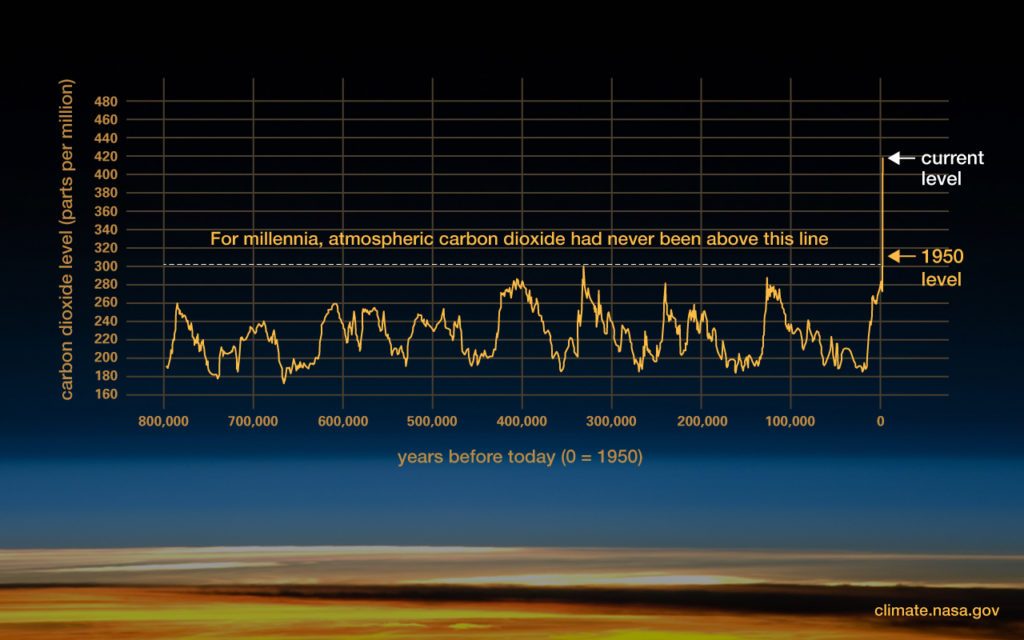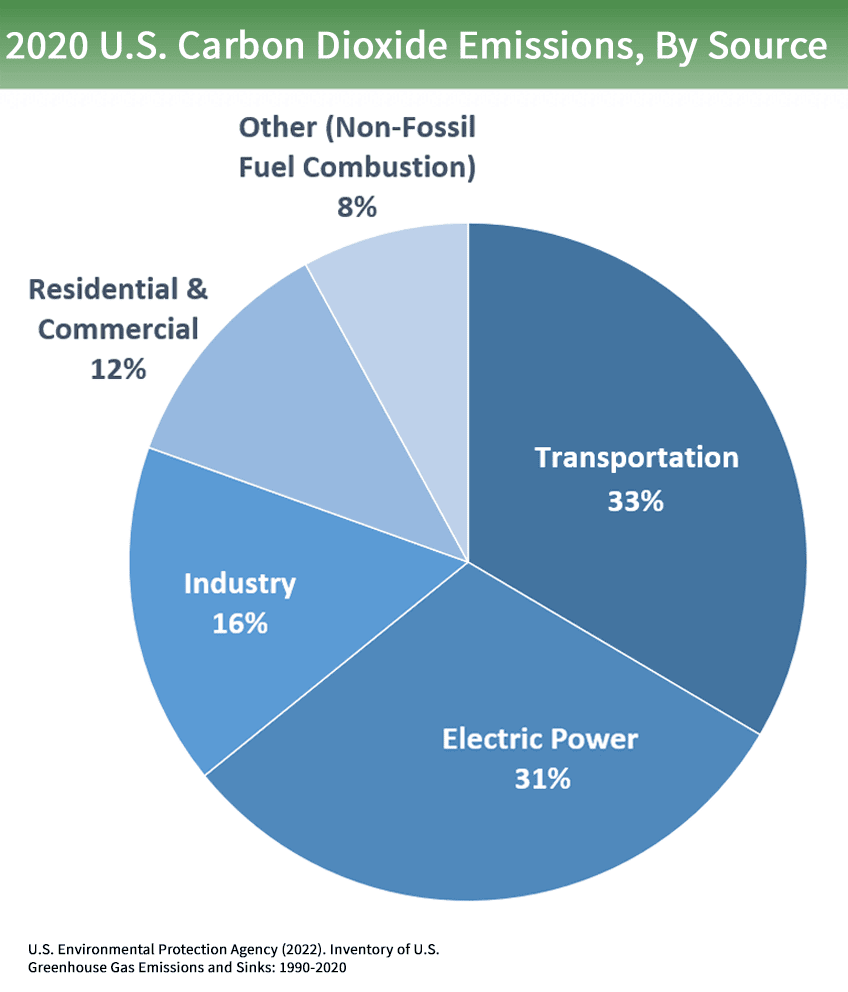Atmospheric carbon dioxide comes from both natural and man-made sources. Carbon dioxide (CO2) is one of the main outputs of combustion, which can take the form of volcanic eruptions, forest fires, or the burning of fossil fuels. Carbon dioxide is also a byproduct of manufacturing (i.e., non-combustion related); for example, it is an intermediate product in cement manufacturing. Looking at natural processes on earth, we note that every living being produces CO2 on the cellular level to produce usable cellular energy. The oceans’ capacity for absorbing CO2 means that these bodies of water are the largest store of CO2 on earth. Through a process known as upwelling, through which oceanic turbulence releases dissolved CO2 back to the atmosphere, the oceans are the largest source of atmospheric CO2.1Wendy Zuckerman, 2011, April 25, “Warmer oceans release CO2 faster than thought,” New Scientist (accessed December 23, 2022).
Overall, atmospheric CO2 levels are higher now than they ever have been. In a noteworthy move, carbon dioxide levels surpassed 400 parts per million (ppm) in 2013.2U.S. Environmental Protection Agency (EPA), 2022, May 16, Overview of Greenhouse Gases, https://www.epa.gov/ghgemissions/overview-greenhouse-gases (accessed December 23, 2022). By 2021, the level was 414 ppm.3U.S. Environmental Protection Agency (EPA), 2022, August 1, Climate Change Indicators: Atmospheric Concentrations of Greenhouse Gases, https://www.epa.gov/climate-indicators/climate-change-indicators-atmospheric-concentrations-greenhouse-gases (accessed December 23, 2022). Throughout history, levels hovered around 200 ppm during ice ages and 280 ppm during warmer periods.

Research supports that fossil fuel combustion is responsible for current levels of atmospheric CO2, as about 60% of all fossil fuel emissions stay in the atmosphere. The National Oceanographic and Atmospheric Administration (NASA) estimates that if anthropogenic fossil fuel combustion continues at current rates until humans completely deplete the resource, then atmospheric CO2 levels could rise as high as 1500 ppm. Projections of greenhouse gas emissions into the next century vary over a wide range, depending on both socioeconomic development and climate policy but the role of CO2 in this process is now accepted by all major governments and most industries.4U.S. Environmental Protection Agency (EPA), 2022, May 16, Overview of Greenhouse Gases, https://www.epa.gov/ghgemissions/overview-greenhouse-gases (accessed December 23, 2022).
CO2 emissions and Human Activity
Anthropogenic or man-made sources also contribute to CO2 in the atmosphere. As part of their national Carbon Storage Atlas project, the U.S. Department of Energy documented 6,358 stationary CO2 sources with total annual emissions of approximatively 3,071 million metric tons of anthropogenic CO2.5National Energy Technology Laboratory, CO2 Stationary Sources, https://netl.doe.gov/node/6096 (accessed December 23, 2022).
1 U.S. customary ton (t) = 2,000 lbs whereas 1 metric ton (MT) (sometimes written as 1 tonne) = 1,000 kg.

Carbon dioxide is the primary greenhouse gas
Carbon dioxide is the primary greenhouse gas emitted through human activities. In 2020, CO2 accounted for about 79% of all U.S. greenhouse gas emissions from human activities. Human activities are altering the carbon cycle–both by adding more CO2 to the atmosphere and by influencing the ability of natural sinks, like forests and soils, to remove and store CO2 from the atmosphere. While CO2 emissions come from a variety of natural sources, human-related emissions are responsible for the increase that has occurred in the atmosphere since the industrial revolution.6U.S. Environmental Protection Agency (EPA), 2022, May 16, Overview of Greenhouse Gases, https://www.epa.gov/ghgemissions/overview-greenhouse-gases (accessed December 23, 2022).
CO2 and the combustion of fossil fuels
The main human activity that emits CO2 is the combustion of fossil fuels (coal, natural gas, and oil) for energy and transportation. Certain industrial processes and land-use changes also emit CO2. The main sources of CO2 emissions in the United States are shown below.7U.S. Environmental Protection Agency (EPA), 2022, May 16, Overview of Greenhouse Gases, https://www.epa.gov/ghgemissions/overview-greenhouse-gases (accessed December 23, 2022).

Carbon dioxide dominates gaseous emissions from the oil industry – contributing more than 99% of all releases to the atmosphere. Around 132 tonnes of CO2 are released per thousand tonnes of oil and gas produced. Of this, around 60% is associated with the energy demands of oil and gas production – operating energy intensive equipment such as pumping. The remainder is dominated by flaring – the combustion of natural gas associated with oil production that cannot be economically captured, processed, and used on-site or sold. Only a small fraction, around 6%, is associated with venting of CO2 dissolved within the oil and released as pressure drops.8Wendy Zuckerman, 2011, April 25, “Warmer oceans release CO2 faster than thought,” New Scientist (accessed December 23, 2022).,9National Energy Technology Laboratory, Carbon Dioxide 101, https://www.netl.doe.gov/research/coal/carbon-storage/carbon-storage-faqs/what-are-the-primary-sources-of-co2 (accessed March 9, 2017).
Earth’s natural capacity to absorb CO2 is decreasing
Besides increase in anthropogenic CO2 emissions, the natural capacity of the planet in absorbing CO2 is decreasing. The oceans and forests play a vital role in capturing and storing CO2 released into the atmosphere. Plants take up carbon dioxide through their leaves and stems, especially during their growth stage, and then store it. Trees have a very high storage capacity, with carbon accounting for 20% of their total weight on average. Forests and oceans combined capture more than half of annual emissions, helping to slow the rise in atmospheric CO2 levels. However, the rapid eradiation of forests, especially the tropical rainforests, is depleting the Earth’s vegetation growth and diminishing its capability for absorbing CO2. The unabsorbed CO2 rises to the upper atmosphere and inhibits the reradiation of solar energy back into space. This trapped heat induces a global temperature increase resulting in global greenhouse effect, mainly carbon dioxide, from anthropogenic activities.10NASA, “The Relentless Rise of Carbon Dioxide,” Global Climate Change, https://climate.nasa.gov/climate_resources/24/ (accessed March 9, 2017)
Reduction in CO2 emitted per unit volume of oil produced
In recent years there have been notable reductions in the amount of CO2 emitted per unit volume of oil produced, dropping by some 10% in almost a decade.11NASA, “The Relentless Rise of Carbon Dioxide,” Global Climate Change, https://climate.nasa.gov/climate_resources/24/ (accessed March 9, 2017) This is a result of improvements in production processes including greater re-injection of unused gases into mature oil reservoirs to maintain pressure and boost production. The industry is making a strong push in reducing CO2 emissions, with recent efforts focused on carbon capture utilization and storage (CCUS): the process of capturing waste CO2, transporting it to a storage site, and injecting it deep underground in a geologic formation where it will not enter the atmosphere; or utilizing the CO2 as a commodity to remove it from the atmosphere.
Images: “Coal power plant” by Kodda via Shutterstock; “Map” by National Energy Technology Laboratory
